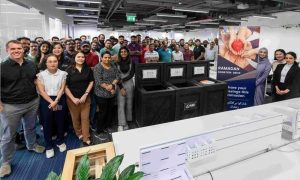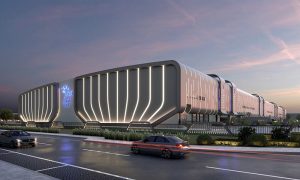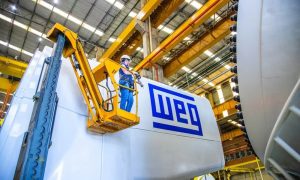Peyman Mohajer reveals WME Consultants’ ambitions for global expansion
Middle East Consultant sits down with WME Consultants’ Peyman Mohajer to discuss engineering excellence and his plans for the future

WME Consultants (WME) is an independent multi-disciplinary consultancy that was founded in 2010. The consultancy was first registered in Abu Dhabi, following which an office was set up in Dubai about a year later. Since then, the company has opened two additional offices, one in London and the other in Bangalore, and today the firm has a headcount of 260 professionals, led by managing director Peyman Mohajer.
The firm’s growth has been spurred on by its ability to offer top-notch engineering services for built environments. But despite its already impressive gamut of expertise, the company is keen on growing its service offering further.
“We offer a variety of engineering services including structural, mechanical and electrical engineering, as well as plumbing, infrastructure and security. We are trying to expand the range of engineering disciplines that we offer, so we can become a one-stop shop to architects and clients. We have an unlimited licence from Dubai Municipality and so we can offer all the engineering services, plus AOR – Architect of Record. We have architects in-house as well, who assist us in delivering or defending projects in front of stakeholders – this is what we are in a nutshell,” explains Peyman Mohajer, managing director at WME Consultants.
In terms of business and despite challenging market conditions regionally and around the world, WME Consultants has enjoyed steady growth across its core disciplines.
“All of our core disciplines are solid. We are growing across sectors but predominately on the MEP and structures fronts. What we’ve noticed is that after clients have worked with us on one project and get a feel for our capabilities, they ultimately come back to us and even refer us to other clients. That’s part of the reason we’ve enjoyed growth in our business, even outside of Dubai.”
He adds: “Another reason clients come back to work with us is because of the personal touch that we offer. I’m accessible 24/7 and clients feel they can call me no matter where I am in the world – clients see that as an advantage. At the same time, our engineers are also very accessible – they make it a point to actively meet and fully understand client concerns and aspirations, their challenges, and try to support them as much as possible.”
Packed Portfolio
Since its inception, WME Consultants has worked on a variety of high-profile projects within the UAE and beyond, including the King’s College Hospital Clinic 1 in Dubai, the Dubai World Central Executive Jet Terminal and the Oberoi Mulund residential development in Mumbai, and it has also worked on the remodel and expansion of Dubai Festival City Mall. The consultancy also has numerous other projects in the design or on-site phase.
“One project that we are very proud of is the UAE Pavilion at Expo 2020. It’s our crowning project and we’re working with Santiago Calatrava, and it has been a great journey. As a project, it is challenging and exciting, and it’s a pleasure for us to work with such iconic architects. This project in particular has really boosted our confidence. We’re also in the detailed design stage of a 105-storey tower on Sheikh Zayed Road, and it is one of the most slender towers you’ll find in the Middle East. Here, WME is working with North American wind tunnel engineers to mitigate wind impact on this building, since this is one of the main factors that governs the design of very tall buildings. It’s innovative in terms of its structural system and slenderness, and that’s what excites our engineers.
“The Fountain Views is another important project that we’re working on – it’s a huge project with four towers and a large podium. It’s the first project that we worked with Emaar on and it’s close to completion now. This is the project that allowed Emaar to discover our capabilities, and led them to work with us on other projects. Personally, I’m very happy with what we have achieved in such a short period of time,” says Mohajer with a smile.
Outside the UAE, the firm has also enjoyed significant success, particularly in India, working with Oberoi Realty.
“In Mumbai, we have quite a few projects with Oberoi Realty, which is one of the blue-chip developers in India. They are cost-conscious and like the way we design and the way we value engineer our designs. They also like that we sympathise with clients and understand their aspirations and restrictions with regard to budget, etc. Basically, we take on the project from an ownership standpoint and they appreciate it,” comments Mohajer.
He further explains that his firm had an unconventional entry into India.
“Oberoi ran a competition for the structural design of 12 70-storey towers in Mumbai. The competition was about three years ago and there were three international structural engineering consultants invited to participate – one from the US, one from Singapore and we were the third, from Dubai. We participated and won the competition, so that’s how we entered the Indian market with Oberoi. Since then, they have been very happy with our services.”
Mohajer, who has 15 years of Middle East experience and previously worked for firms such as Whitby & Bird and Ramboll, says his firm has also worked on infrastructure projects in Saudi Arabia. “We support the master-planners with infrastructure, and we’ve also designed a couple of hotels in the Kingdom.”
Expansion Ambitions
In an effort to further strengthen its business, the firm is eyeing expansion into several markets around the globe, and reckons it is already set up for success.
“We are looking farther East now, especially at Southeast Asia. We’d like to be in that market because some of the architects who we work with are based in Singapore and Hong Kong, and as we deliver projects together, they encourage us to enter that part of the world. We offer a very unique service, thanks to the quality of people we have – they are all handpicked,” explains Mohajer.
With regard to hiring and retaining the right talent, which can sometimes be a challenge in the region, he notes: “As a result of my work experience, I’ve made a lot of contacts, and over the years we’ve been able to hand pick the people that we think are able to offer unique value to the company and to this market. That’s paying dividends, and we’re now bringing in people to strengthen our MEP offering.”
“We’re patient as a company and we know who we want. Once we have recruited people, our goal then becomes to keep them as happy as possible. We want our staff to look forward to coming in to work and so we have a lot of fun together. Our HR team plays a key role in making sure the right environment is created, through social events, through personal interactions and by making sure there are no grievances or, if there are, that they are addressed quickly and to the satisfaction of staff.”
Mohajer is keen to point out that Dubai is still the heart of his firm’s business.
“Dubai is the centre of excellence. We built our experience here and now we’ve started to export that experience overseas. We’re bidding for projects in Kazakhstan, Uzbekistan, India, and are expanding our field of operation. I think this is what is going to ensure our sustainability – opportunities in Dubai mixed with international business.”
Expansion is on the cards for WME. The firm is eyeing the North American market, and believes out-of-the-box thinking will enable it to replicate its success in Dubai in other markets.
“We’re looking at North America and, as I mentioned earlier, Southeast Asia. These are all in our radar, in line with our global ambitions. I think the service we are offering is unique in terms of quality and innovation, and we are really pushing the boundaries, especially when it comes to iconic structures. This, again, is thanks to our work in Dubai. The experience we gained in Dubai during the boom time and the projects that we have delivered are dream projects that any engineer would want to be a part of. This, I believe, makes our company unique in terms of collective experience. At the same time, we can be very competitive because we don’t have the overheads of the international companies.”
Leveraging Technology
Technology and innovations such as BIM have held the interest of the construction industry over the last couple of years, and WME was quick to adopt and integrate the technology into its workflow.
“As structures get more complicated, there’s a greater chance of human error. In the past, coordination and updates between stakeholders could be missed and would only get picked up on-site. That could be very embarrassing for the consultant and for the client, but now what we’ve done is, we’ve implemented BIM360, which is a cloud-based design collaboration platform. This allows everyone (consultant, architect, client, etc) to work together from different locations and interact directly with models and drawings, using a mobile device to review the building. So even at the early stages of the project, it’s possible to look at the interface between structure and MEP, for example.”
Mohajer notes that BIM will continue to evolve, and says he is committed to ensuring that his firm remains on the forefront.
“As the technology evolves and new solutions come onto the market, WME will implement it. We are looking at apps now – our project managers use them so that, wherever they are, they can access drawings. These tools help us to work better with stakeholders, which will result in better projects. At the end of the day, everything we take on is something we are proud of, and we want other people to be proud of our work as well. That’s our culture.”














